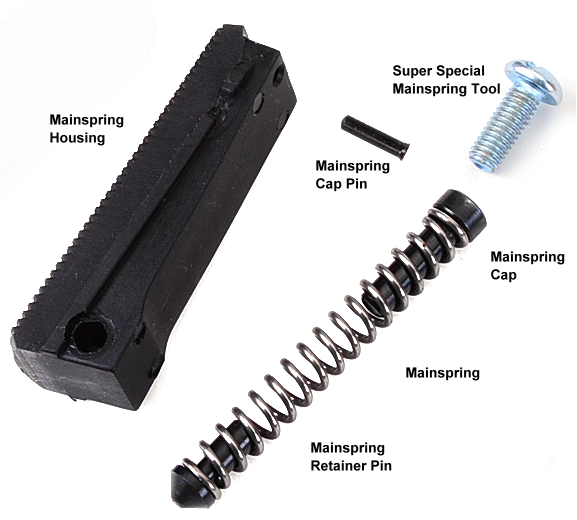I’m pretty sure Facebook, and many current message boards, are the manifestation of a growing communist philosophy. Their intent is to use peer pressure to negotiate enthusiastic and creative people down to the lowest group consensus denominator. If a person suggests that they want to try something different, they will immediately be berated until they yield or are ostracized from the group. Where subjective selection and alternative solutions once flourished, all too many novice enthusiasts are being groomed and sent to the range or field with a firearm that looks just like all others.
The whole concept of “Shoot what I shoot”, “Buy only within MY budget” and “Modify only as I modify” is a bit bizarre, and substantially contradictory for these lock step conformists who typically worship John Browning as their patron saint. I think it is fair to say that if John Browning had a Facebook account, or participated on message boards, there would be a hundred or so less revolutionary and evolutionary firearms in existence. To the genuine firearm enthusiast, companies like Brownells represent a toy store where anything and everything is possible. For the comrades in our midst, these companies represent a confusing jungle of possibilities, fraught with way too many unique thinking.
But what about you, Joe? You’re always trying to tell us what to do. No, I am always telling you what I’M doing, why I am doing it and what I hope to accomplish with the effort. You are perfectly free to read what ever micro manifesto I’ve concocted, study in what manner I’ve maimed a firearm, decide if the effort is worthwhile or not and if it suits you personally. What you are not free to do is insist I follow the teachings of your Facebook or message board messiah.
Still fiddling with the Para-USA Elite Commander

In the case of this Para-USA Elite Commander, the bits and pieces I didn’t like were its short guide rod, thin double diamond grip panels and plain fasteners, and its plastic mainspring housing. All but the last was previously corrected. Yes, I do use full length guide rods on my 1911 type pistols for the reasons offered in the article. All that remained was changing out the mainspring housing.

With the firearm checked for empty, the magazine removed and with the gun uncocked, the mainspring housing pin at the heel of the grip frame is pushed out left to right. A brass or nylon punch and light tap will do when pushing out the pin as it is only retained by side loaded spring pressure.
Something to fill in that big empty space…
There are many replacement mainspring housings available sizes for 1911 type pistols. Some are flat, some are arched, some bobtailed, some are extended, some include a magazine feed well. They are bare stainless and blued, checkered, striated and fish scaled. Yes, the proper word is “striations”, a series of parallel ridges, not “serrations” which is a saw like form. Virtually no replacement mainspring housing includes a hammer spring, mainspring cap, cap pin, or retaining pin so either a rebuild kit (Brownells # 080-000-549WB Mainspring Housing Rebuild Kit $9) is required for installation, or parts are carried over from the original assembly. Mainspring housing prices range from $16 to $174.

Pictured above, left to right: Brownells #124-153-100WB Les Baer $38.35, Brownells # 555-102-001WB John Masen $18.99 and the original poly housing that came installed on the Elite Commander. I actually have a number in bench stock because it is easier to juggle for proper fit than to rework and refinish. My approach to trial fit until I find one that is snug, but does not require force to fully seat. Force fitting a mainspring housing will distort the pistol’s frame and possibly cause permanent damage. If you only have one piece and it is tight, you can coat the sides with Dychem and conservatively file and stone away high areas to fit.

Sliding the unassembled mainspring housing into the frame to trial fit, you need to make sure the tip of the hammer strut, arrow, goes into the spring well so the mainspring housing can go all the way into position. Without the mainspring in place, it is easy to push the housing into alignment with the mainspring housing pin holes and check to make sure the grip safety clears the top of the mainspring housing. Newer replacement housings have really closed up that gap for a much cleaner look, so it is good to check clearance.
What is the difference between transplanting and transferring…

The mainspring cap pin is held under pressure from the mainspring cap and retained when the cap is depressed by the hammer strut. The super special mainspring tool, AKA 1/2″ 10-20 screw, is inserted against the top of the mainspring cap and then either pressed against the side of a work table until the cap pin is unloaded and falls, hopefully, in the palm of your hand. Pressure is then eased and the inner spring assembly will be free. The mainspring rate is about 26 lbs, so there is no shame in using a vise to compress the super special tool into the housing… with hand under the housing to catch the cap pin when it drops out. Reverse the process to move the pieces into the new mainspring housing.
And then? And then?
With the new housing assembled, the hammer strut will see resistance from the mainspring cap. I usually just press the heel of the pistol down on the workbench to position the mainspring housing the and start the mainspring housing pin into position. The pin can be tapped fully into place with a non-marring nylon punch.

Almost done. I know I am going to change the physical trigger and a trigger job is on the list of things to do before the Para-USA Elite Commander is just right.

Email Notification